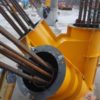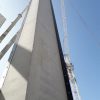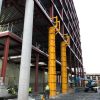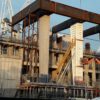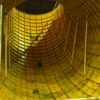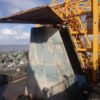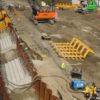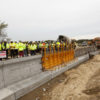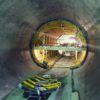Hinkley Point C – Travelling Formwork system – 2018
KierBAM JV have recently completed a 800 metre long mass concrete sea wall to protect the site at the new Hinkley Point C Nuclear Power station in Somerset. The massive nature of the structure required a novel approach. Special Formwork developed the concept of casting the wall as a series of individual ‘buttresses’ with longer Infill pours. They needed a set of formwork that could be quickly stripped and moved to the next pouring position between tides. By utilizing a travelling formwork system it virtually eliminated the use of cranes for setting moving and striking the forms – an important consideration for a very exposed coastal site.
Casting a series of ‘buttress’ blocks, with longer ‘Infill’ pours eliminated the need for any ‘single sided’ formwork to stop ends – which would have been time consuming and require a large number of anchors, tie rods and very expensive craneage given the large number of pours to be completed.
Special Heavy Duty anchors were built in to the kicker pours which virtually eliminated the need for long conventional through ties between landward and seaward faces – most of which would have been lost in the pour due to difficulty in extracting such long ties.
Shorter recoverable tie rods are used to connect the stop ends to each other. The relatively small number of anchors per pour resulted in significantly less manpower being needed to strike and reset the forms – particularly during the tidal ‘window’.
The Formwork and traveller were manufactured, trial assembled and fully tested at our works saving valuable time on site. The formwork was shipped in large pre-assembled pieces in a series of wide loads again saving re-assembly time and crane waiting time on site. The Formwork and access is suspended from a traveller which is propelled using hydraulic motors and is mounted on wheels which travel on railway track. The formwork comprises four panels which can be opened hydraulically and raised so the whole assembly can travel to its next position without the need for disassembly.
The structure can quickly be adjusted by wireless remote control enabling operation from a safe position using hydraulic rams. The legs can be raised and lowered independently, as pairs or all together to accommodate any variations in height of the base pour. The Stop ends can be individually lifted and the whole formwork can be moved crossways for alignment.

